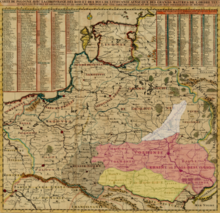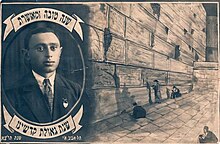Volhynia
Volhynia
Волинь | |
|---|---|
Historical region | |
| |
|
Southwestern Belarus, Western Ukraine | |
| Parts | Volyn Oblast, Rivne Oblast, Zhytomyr Oblast, Ternopil Oblast, Khmelnytskyi Oblast, Lublin Voivodeship, Brest Region |
| Demonym | Volhynian |
Volhynia (also spelled Volynia) (
Volhynia has changed hands numerous times throughout history and been divided among competing powers. For centuries it was part of the
Names and etymology
- Ukrainian: Воли́нь, romanized: Volýnʹ;
- Polish: Wołyń;
- Lithuanian: Voluinė or Volynė;
- Slovak: Volyňa;
- Czech: Volyň;
- Romanian: Volhînia;
- Hungarian: Volhínia;
- German: Wolhynien or Wolynien (both [voˈlyːni̯ən] ⓘ); Volhynian German: Wolhynien, Wolhinien, Wolynien or Wolinien (all [voˈliːni̯ən]);
- romanized: Vohlin.
The alternative name for the region is Lodomeria after the city of Volodymyr, which was once a political capital of the medieval Volhynian Principality.
According to some historians, the region is named after a semi-legendary city of Volin or Velin, said to have been located on the
Geography

Geographically it occupies northern areas of the
Relative to other historical regions, it is northeast of
The territories of historical Volhynia are now part of the Volyn, Rivne and parts of the Zhytomyr, Ternopil and Khmelnytskyi Oblasts of Ukraine, as well as parts of Poland (see Chełm). Major cities include Lutsk, Rivne, Kovel, Volodymyr, Kremenets (Ternopil Oblast) and Starokostiantyniv (Khmelnytskyi Oblast). Before World War II, many Jewish shtetls (small towns), such as Trochenbrod and Lozisht, were an integral part of the region.[3]: 770 At one time all of Volhynia was part of the Pale of Settlement designated by Imperial Russia on its southwesternmost border.[4]

History
The first records can be traced to the Ruthenian chronicles, such as the
Volhynia may have been included in (or was in the sphere of influence of) the Grand Duchy of Kyiv (Ruthenia) as early as the tenth century. At that time Princess
As early as 983, Vladimir the Great appointed his son Vsevolod as the ruler of the Volhynian Principality. In 988, he established the city of Volodymer (Володимѣръ).
Volhynia's early history coincides with that of the duchies or principalities of


After the disintegration of the
After the
In 1897, the population amounted to 2,989,482 people (41.7 per square kilometre). It consisted of 73.7 percent East Slavs (predominantly
Ukrainian People's Republic
After the
Interwar period


In 1921, after the end of the Polish–Soviet War, the treaty known as the
Most of eastern
From 1935 to 1938, the government of the
World War II
Following the signing of the
During the German invasion,the Jewish population in Volhynia was approximately 460,000. About 400,000–450,000 Jews and
The Soviet Union annexed Volhynia to Ukraine after the end of World War II. In 1944, the communists in Volyhnia suppressed the Ukrainian Catholic Apostolic Exarchate. Most of the remaining ethnic Polish population were
Important relics
Famous personalities
- Dov Ber of Mezeritch, rabbi
- Hayim Nahman Bialik, literary figure
- Shlomo Flam, rabbi
- Moisey Kasyanik, weightlifter
- Sergei Korolev (1907–1966), Soviet rocket engineer and spacecraft designer.
- Malbim, rabbi
See also
- Kingdom of Galicia–Volhynia
- Galicia (Eastern Europe)
- Massacres of Poles in Volhynia and Eastern Galicia
- Historiography of the Volyn tragedy
- Polish Autonomous District
- Kresy Wschodnie
- Volhynian folk costume
References
- ISBN 9785892160292.
- ISBN 9789660220744. Archivedfrom the original on 2021-06-30. Retrieved 2021-09-28.
- ISBN 9780521362900. Archived from the original on 2021-10-03. Retrieved 2023-02-11 – via Google Books.
- ISBN 9780028660974. Archived from the original on 2021-08-11. Retrieved 2021-09-28 – via Encyclopedia.com.
- ISBN 9780140455076 – via the Internet Archive.
- .
- OL 7001513M – via the Internet Archive.
- ^ "The Effects of the Volhynian Massacres". Volhynia Massacre. Institute of National Remembrance. Archived from the original on 2021-05-01. Retrieved 2021-09-28.
Literature
- Andriyashev, Alexander (1887). Очерк истории Волынской земли [Essay on the History of Volyn land] (in Russian) at Djvu and PDF formats. Kyiv: Imperial University of Saint Vladimir.
- Ciancia, Kathryn (September 2017). "Borderland Modernity: Poles, Jews, and Urban Spaces in Interwar Eastern Poland". The Journal of Modern History. 89 (3): 531–561. S2CID 149342133.
- Litwin, Henryk (October 2016). "Central European Superpower". Business Ukraine. pp. 26–29. Archived from the original on 2020-08-09. PDF version at the Wayback Machine (archived 2016-11-12).
- Merten, Ulrich (2015). Voices from the Gulag: Oppression of the German Minority in the Soviet Union. Lincoln, NE: American Historical Society of Germans from Russia. ISBN 9780692603376
- Potocki, Jan (1805). Histoire anciènne du gouvernement de Volhynie: pour servir de suite à l'histoire primitive des peuples de la Russie (in French) at Polona. Saint Petersburg: Imperial Academy of Sciences.
External links
- American Historical Society of Germans from Russia in Lincoln, Nebraska
- GCatholic - Diocese of Lodomeria, Ukraine
- GCatholic - Ukrainian Apostolic Exarchate of Volhynia, Polesia and Pidliashia
- Imperial Russian Volhynia Governorate Map at the Wayback Machine (archived 2014-03-28), from the Roll "Fame" Family Genealogy website
- The Journey to Trochenbrod and Lozisht Aug 2006
- The Society for German Genealogy in Eastern Europe
- The Swiss Mennonite Cultural & Historical Association
- Volhynia.com
- wolhynien.de (in German)




